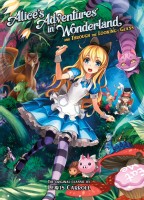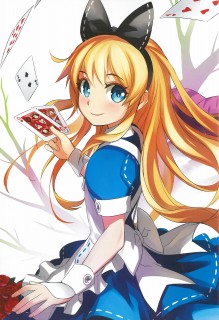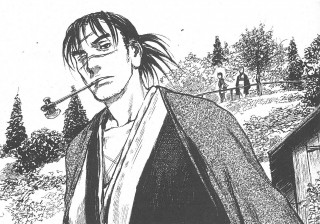 Author: Lewis Carroll
Author: Lewis Carroll
Illustrator: Kriss Sison
U.S. publisher: Seven Seas
ISBN: 9781626920613
Released: August 2014
Original release: 1865, 1871
Alice’s Adventures in Wonderland and Through the Looking-Glass and What Alice Found There are two well-loved, oft-adapted, and extremely influential novels written by Lewis Carroll, the pseudonym of English author Charles Lutwidge, in 1865 and 1871 respectively. I was initially a little surprised when Seven Seas announced that it would be publishing a newly illustrated omnibus edition of the novels in 2014, especially as the company had moved away from publishing prose works in recent years in order to focus on manga and other comics. However, the novels do nicely complement Seven Seas’ releases of the various Alice in the Country of manga. What makes Seven Seas’ edition of Alice’s Adventures in Wonderland and Through the Looking-Glass stand out from others are the incredibly cute and charming manga-influenced illustrations by Kriss Sison, an International Manga Award-winning artist from the Philippines. In addition to a gallery of color artwork, hundreds of black-and-white illustrations can be found throughout the volume.
Alice was enjoying a leisurely afternoon on a riverbank with her older sister when a very curious thing happened—a rabbit with a pocket watch hurries by talking to itself. When Alice follows after it she tumbles down a rabbit hole to find herself in a very strange place indeed. What else is there to do for an inquisitive and adventurous young girl but to go exploring? And so she does. As Alice wanders about she discovers food and drink that cause her to grow and shrink, animals of all sizes and shapes that can talk, and people who have very peculiar ways of thinking about and approaching life. Eventually she returns home to her sister, but several months later she finds herself once again slipping into a fantastical world when she crawls through the mirror above a fireplace mantel. Of course, Alice immediately sets off exploring, encountering even more strange and wondrous things and meeting all sorts of new and perplexing people.
 Despite already being familiar with the story of Alice’s Adventures in Wonderland and Through the Looking-Glass (mostly through the seemingly infinite number of adaptations and otherwise Alice-inspired works) and despite having been encouraged for years by devotees of Carroll’s writings, I had never actually read the original novels for myself until I picked up Seven Seas’ edition. I’m really somewhat astonished that it took me so long to do so and it truly is a shame that I didn’t get around to it sooner. Alice’s Adventures in Wonderland and Through the Looking-Glass is absolutely marvelous and an utter joy to read. It’s easy to see why the novels have been treasured and continue to be treasured by so many people for well over a century. The books are incredibly imaginative and delightfully clever. Carroll liberally employs puns and other wordplay, turning nonsense into logic and vice versa. Alice’s Adventures in Wonderland and Through the Looking-Glass has been translated into something like seventy different languages; though certainly worthwhile, I can’t imagine these interpretations were easy to accomplish due to the novels’ linguistic complexities.
Despite already being familiar with the story of Alice’s Adventures in Wonderland and Through the Looking-Glass (mostly through the seemingly infinite number of adaptations and otherwise Alice-inspired works) and despite having been encouraged for years by devotees of Carroll’s writings, I had never actually read the original novels for myself until I picked up Seven Seas’ edition. I’m really somewhat astonished that it took me so long to do so and it truly is a shame that I didn’t get around to it sooner. Alice’s Adventures in Wonderland and Through the Looking-Glass is absolutely marvelous and an utter joy to read. It’s easy to see why the novels have been treasured and continue to be treasured by so many people for well over a century. The books are incredibly imaginative and delightfully clever. Carroll liberally employs puns and other wordplay, turning nonsense into logic and vice versa. Alice’s Adventures in Wonderland and Through the Looking-Glass has been translated into something like seventy different languages; though certainly worthwhile, I can’t imagine these interpretations were easy to accomplish due to the novels’ linguistic complexities.
What particularly impresses me about Alice’s Adventures in Wonderland and Through the Looking-Glass are the novels’ broad appeal. Both children and adults can easily enjoy the works. Younger readers will likely be amused and drawn to their silliness while more mature readers will be able to more fully appreciate the cleverness of Carroll’s prose, poetry, and song. I would wholeheartedly encourage just about anyone to read Alice’s Adventures in Wonderland and Through the Looking-Glass. Even without counting the multitude of adapted works, there are a huge number of editions of the original two novels available. There is bound to be a version that will appeal, whether it be Martin Gardner’s extensively annotated editions, which reveal references that modern readers are apt to miss, or one of the many illustrated releases. While I may one day move on to The Annotated Alice, I was very pleased with Seven Seas’ Alice’s Adventures in Wonderland and Through the Looking-Glass. Carroll’s novels and Sison’s illustrations are a delightful combination. I am very glad to have finally read the novels and anticipate reading them again with much enjoyment.







